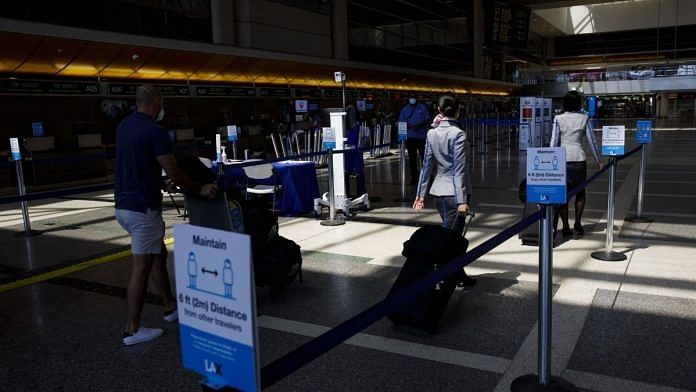Washington: The U.S. is ending its Covid-19 screening of international travelers arriving at airports as airlines seek new ways to more aggressively test for the virus to boost anemic traffic.
The Centers for Disease Control and Prevention said it is ending its program that directed all flights from high-risk areas to 15 U.S. airports. The system was deemed ineffective because so many people who transmit the disease don’t show symptoms, the CDC said.
The government will now focus more on voluntary measures, such as educating passengers and requesting contact information electronically. The health screening will end on Sept. 14.
“We now have a better understanding of Covid-19 transmission that indicates symptom-based screening has limited effectiveness,” the agency said in a news release Wednesday.
The action comes long after people arriving from foreign nations such as China or those in Europe were the primary means of transmission in the U.S. More than 6 million people have contracted the coronavirus in the U.S., and more than 190,000 have died.
Aviation and travel-industry groups in the U.S. and Europe are separately attempting to reopen international travel routes by imposing some type of rapid virus testing, either before people leave or as they arrive.
Airlines for America, a trade group representing major U.S. carriers, is one of those seeking the new testing. But it had also been urging the Trump administration to halt the existing CDC health screening.
“We continue to support spending scarce screening resources where they can best be utilized and no longer believe that it makes sense to continue screening at these 15 airports given the extremely low number of passengers identified by the CDC as potentially having a health issue,” the trade group said in a statement.
The CDC and other health organizations say large numbers of people who are infected never show symptoms, which would limit the ability of the screening to stop the spread.
Airport health screening in reaction to the Covid-19 epidemic has morphed this year as the threat emerged.
The CDC announced on Jan. 17 that it was working with the Department of Homeland Security’s Customs and Border Protection division to conduct health screenings for people traveling to the U.S. from Wuhan, China. Wuhan was the city where the pandemic originated late last year.
At the time, the CDC sent about 100 staffers to airports in San Francisco, New York and Los Angeles to help conduct the screening.
The screening for passengers from China was expanded by presidential decree on Jan. 31, though flights between the two nations were effectively ended for several months starting in March.
The government announced dramatically expanded health screening for American citizens and legal residents returning to the U.S. on March 13, creating long lines at airports. The program drew intense criticism initially as people fled the pandemic in Europe and thousands were packed together without social distancing.
Passengers were asked about their medical history and current health, and required to provide contact information for local officials.
The pandemic has generally hit international routes — particularly the profitable tracks to Europe and parts of Asia — far harder than domestic U.S. flying.
U.S. airlines have lost more than 90% of passengers flying across the Atlantic and Pacific this year compared with 2019, and the levels have moved up only slightly in recent months, according to data from Airlines for America.
By comparison, domestic U.S. passengers in the past week averaged 63% below last year, TSA data shows. – Bloomberg
Also read: Trump says he downplayed coronavirus threat to avoid creating panic






